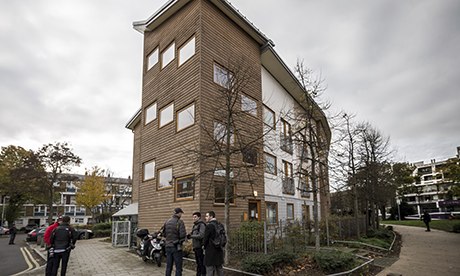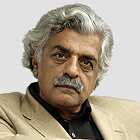What the Maoist slavery sect tells us
about the far left
Far-left 'splittist' sects like Comrade Bala's proliferated in the 70s – and a genuine desire for change was corrupted

Journalists outside Peckford Place in Brixton, one of the properties linked to Aravindan and Chanda Balakrishnan, arrested on suspicion of holding three woman captive at addresses in south London. Photograph: Guy Corbishley/ Guy Corbishley/Demotix/Corbis
The recent Monty Python revival has come with a bizarre reminder from south London that once, long ago, there were a few tiny Maoist groups in Britain who used language that could have been cribbed from Life of Brian.
Aravindan Balakrishnan, 73, and his 67-year-old wife, Chanda – arrested last week on suspicion of holding three women as slaves in a flat for 30 years – were leaders of a tiny sect of 25 members known as the Workers' Institute of Marxism-Leninism-Mao Zedong Thought, invisible to the left at large. This sect had split from its father organisation, the Communist party of England (Marxist-Leninist), which itself had less than a hundred followers. The Maoists' antics were rivalled by a number of Trotskyist sects, smaller and larger, whose implosion often involved the mistreatment of women, and the story is by no means over.
The Balakrishnans' Brixton commune, it is now alleged, kept three women as virtual prisoners against their will. But it prospered. Membership declined, but property increased. The Balakrishnans pre-empted China's turn to capitalism – according to some reports they had interests in 13 properties, three more than their total membership at the time.
What was the attraction of Maoism? The figure of Mao and the revolution loomed large, but the outpourings from these groups did not suggest a close reading of On Contradiction or other texts by Mao that might have stimulated the brain cells. Instead they became fantasy outfits, each with its own homegrown Mao playing on the genuine desire for change that dominated the 1967-77 decade.
As a political current, Maoism was always weak in Britain, confined largely to students from Asia, Africa and Latin America. This was not the case in other parts of Europe. At its peak, German Maoism had more than 10,000 members, and the combined circulation of its press was 100,000. After the great disillusionment – as the Chinese-US alliance of the mid-70s was termed – many of them privatised, and thousands joined the Greens, Jürgen Trittin becoming a staunch pro-Nato member of Gerhard Schröder's cabinet. In France, the Gauche Prolétarienne organised workers in car factories, and set up Libération, its own paper that morphed into a liberal daily. Ex-Maoist intellectuals occupy significant space in French culture, though they are now neocons: Alain Finkielkraut, Pascal Bruckner, Jean-Claude Milner are a few names that come to mind. The leading leftwing philosopher Alain Badiou never hides his Maoist past.
Scandinavia was awash with Maoism in the 70s. Sweden had Maoist groups with a combined membership and periphery of several thousand members but it was Norway where Maoism became a genuine popular force and hegemonic in the culture. The daily paper Klassekampen still exists, now as an independent daily with a very fine crop of gifted journalists (mainly women) and a growing circulation. October is a leading fiction publishing house and May was a successful record company. Per Petterson, one of the country's most popular novelists, describes in a recent book how, when Mao died, 100,000 people in a population of five million marched with torches to a surprised Chinese embassy to offer collective condolences. All this is a far cry from the cult sect now being excavated in Brixton.
What always struck me even then as slightly odd was that, regardless of the political complexion of a sect, the behavioural patterns of its leaders were not so different. Even those most critical of Stalinist style and methods tended to reproduce the model of a one-party state within their own ranks, with dissent limited to certain periods and an embryonic bureaucracy in charge of a tiny organisation. It was in western Europe, not under Latin American or Asian military dictatorships, that clandestinity and iron discipline were felt to be necessary.
Young women and men who joined the far-left groups did so for the best of reasons. They wanted to change the world. Many fought against the stifling atmosphere in many groups. Women organised caucuses to monitor male chauvinism inside the groups and challenged patriarchal practices. Pity that not all the lessons were learned. Easy now to forget that many who fought within and led the women's and gay liberation movements – in Europe and elsewhere – had received their political education inside the ranks of the combined far left, warts and all.
I can still recall a South American feminist calmly informing a large gathering of revolutionaries in the 70s that advances were being made against machismo. "Only last year," she declared, "my husband, who is sitting on the platform, locked me in the house on 8 March so I couldn't join the International Women's Day demonstration." The husband hid his face in shame.
Now the 70s really does seem another country. The thunder of money has drowned much that was and is of value. The campaign to demonise trade unions – indeed, any form of non-mainstream political activism or dissent – continues apace, despite the fact that the left has never been weaker. A sign, perhaps, that the votaries of the free market remain fearful of any challenges from below.

No comments:
Post a Comment